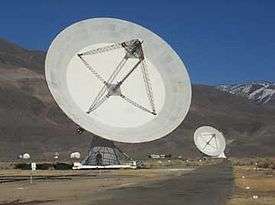Owens Valley Solar Array
 | |
| Observatory |
Owens Valley Radio Observatory |
|---|---|
| Location(s) | California, US |
| Coordinates |
37°13′54″N 118°17′35″W / 37.2317°N 118.293°WCoordinates: 37°13′54″N 118°17′35″W / 37.2317°N 118.293°W |
| Organization |
New Jersey Institute of Technology |
| Altitude |
1,200 m (3,900 ft) |
| Telescope style |
Radio telescope Solar telescope |
| Website |
www |
 Location of Owens Valley Solar Array | |
The Owens Valley Solar Array (OVSA) is an astronomical radio telescope array with main interests in studying the physics of the Sun. The instruments of the observatory are designed and employed specifically for studying the activities and phenomena of our solar system's sun. Other solar dedicated instruments operated on the site include the Solar Radio Burst Locator (SRBL), the FASR Subsystem Testbed (FST), and the Korean SRBL (KSRBL). The OVSA is operated by the New Jersey Institute of Technology (NJIT), which also operates the Big Bear Solar Observatory.
The OVSA is located at Owens Valley Radio Observatory (OVRO), near Big Pine, California.
The facility was built by the California Institute of Technology in 1982. Management of the observatory was transferred to NJIT in 1997. At the time of transfer the site had 5 antennas including two 27-m antennas (originally used to study radio galaxies), and three 1.8-m antennas. Two more 1.8-m antennas were added later. Funding comes from the National Science Foundation and NASA.
Instruments


The array employs its seven antennas to perform radio interferometry at up to 86 radio frequencies ranging from 1 to 18 gigahertz (microwave range). The combination of spatial and spectral resolution is called microwave imaging spectroscopy, which provides rich diagnostic information about the Sun. It is sensitive to both thermal radiation from the chromosphere and corona of the Sun, and to non-thermal radiation from high-energy electrons accelerated in solar flares.
The array has also been used in the discovery and study of the effects of solar radio bursts on wireless communication systems, including cell phones and the Global Positioning System (GPS). Such effects are aspects of Space weather.
See also
- Owens Valley-related topics
- List of observatories
References
| Wikimedia Commons has media related to Owens Valley Solar Array. |
- "Owens Valley Solar Array homepage". Owens Valley Solar Array. Retrieved January 13, 2008.
External links
- Department of Physics at NJIT